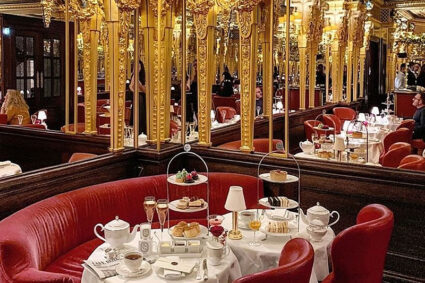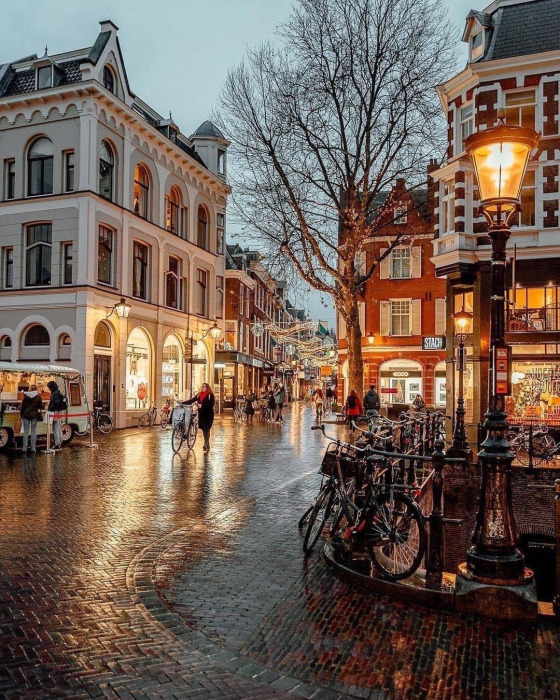
In the heart of Japan, Kyoto stands as a living testament to the a seamless blend of ancient traditions and the vibrant pulse of modernity. A city where history whispers through the rustling leaves of its ancient temples. Where their centuries-old stories etched in every wooden beam, stand as guardians of Kyoto’s rich history. But look closer, and you’ll find that these temples are not mere relics; they are living narratives, embraced by the hum of everyday life. As you traverse the city, vibrant traditions likewise unfold like the petals of cherry blossoms in spring. Kyoto promises an amazing journey through time for those fortunate enough to step onto its paved streets.
History Preserved in Every Stone
Kyoto’s story began over a millennium ago when it became the imperial capital in 794. Since then, its commitment to preserve its heritage is not frozen in time; it’s a city in perpetual motion. Modernity coexists seamlessly with tradition, significantly revealing itself in the sleek lines of contemporary architecture and the buzzing energy of Pontocho Alley’s nightlife.
Expect surprises around every corner, from quirky themed cafes to avant-garde art installations that evidently challenge perceptions. Let the city’s history envelop you, its modernity surprise you, and its people welcome you into the heart of an uncharted joy.
Journey Through Kyoto, Japan for the Curios Traveler
Embrace the rhythm of Kyoto by immersing yourself in its offerings.
1. Temples and Tranquility:
Kyoto, Japan boasts over 2,000 temples, each with a particularly unique story to tell.

The Zen gardens at Ryoan-ji Temple
Famous for its rock garden, Ryoan-ji is a Zen temple that provides a rather tranquil setting for contemplation. Find tranquility amid carefully arranged rocks that evoke a profound sense of simplicity
Kinkaku-ji (Golden Pavilion)Temple
Explore the serenity of Kinkaku-ji, where the Golden Pavilion glows like a phoenix rising from the ashes of its past and reflections dance on the shimmering surface of the pond.


Check out To-ji Temple a home to the tallest wooden pagoda in Japan. To-ji is a UNESCO World Heritage Site and very striking especially at the night time.
Each temple, each stone path, carries the imprints of emperors, samurai, and poets, creating a timeless resonance that transcends the ages
2. Tea Ceremonies and Cultural Nourishment:

Step into the sacred space of a traditional tea house, where the aroma of matcha undeniably transcends time, inviting you to partake in a ritual that has been perfected through generations. In these serene corners, Kyoto whispers the wisdom of its elders. Basically, urging you to savor each moment, each sip, as if it were the elixir of life itself. Places like Uji, just south of Kyoto, are known for producing some of the finest matcha in Japan. Engage in a traditional tea ceremony and discover a world where each gesture holds profound meaning.
3. Cherry Blossom Revelry and Fall Foliage:

Spring transforms Kyoto into an undeniably magical realm as cherry blossoms. It’s an enchanted season that showers the city with delicate hues of pink and white. Cherry blossoms, or sakura, are not just flowers in Kyoto. They are the heartbeat of a city that comes alive with a gentle, fleeting beauty. It’s surprisingly not just about witnessing nature’s spectacle. More particularly, it’s about feeling the delicate petals underfoot, feeling the cool breeze that carries the promise of renewal, feeling the collective joy that permeates the air. Or better still, join the locals in hanami, a celebration of flower viewing, and feel the collective joy that blankets the city.

Unlike the fleeting charm of cherry blossoms that grace us for a mere few days, the fall foliage graciously lingers for up to two months, allowing you to bask in its restrained elegance. The transformation begins in October, crescending to a peak of mesmerizing colors in mid-November, with the breathtaking display lingering until mid-December.

Find solace in the serene beauty of Kiyomizu-dera in Kyoto Japan, a wooden marvel perched on the hills, offering panoramic views of cherry blossoms in spring and crimson foliage in autumn. The main hall stands on wooden pillars without the use of nails. It’s a marvel in itself!
Kyoto’s seasons significantly impact the experience. Cherry blossom season (spring) and fall foliage season (autumn) are particularly popular but can be crowded. Plan your visit accordingly if you want to witness these natural spectacles.
4. Nishi Market and Culinary delights:
Indulge in Kyoto’s culinary wonders, where over 200 restaurants grace the prestigious Michelin Book.

Among these, stands the venerable Kikunoi, a century-old culinary haven orchestrated by the unparalleled Chef Yoshihiro Murata—the sole maestro globally to command seven Michelin stars.
Prepare your palate for a combination of flavors in the heart of Kyoto’s gastronomic excellence!”
Explore the vibrant Nishiki Market, where the aroma of street food intertwines with the melody of vendors hawking their wares. Nishiki Market in Kyoto Japan is a sensory expedition through culinary wonders.
Aptly known as “Kyoto’s Kitchen,” this narrow, bustling arcade entices you with a vibrant scope of sights, sounds, and tantalizing aromas.
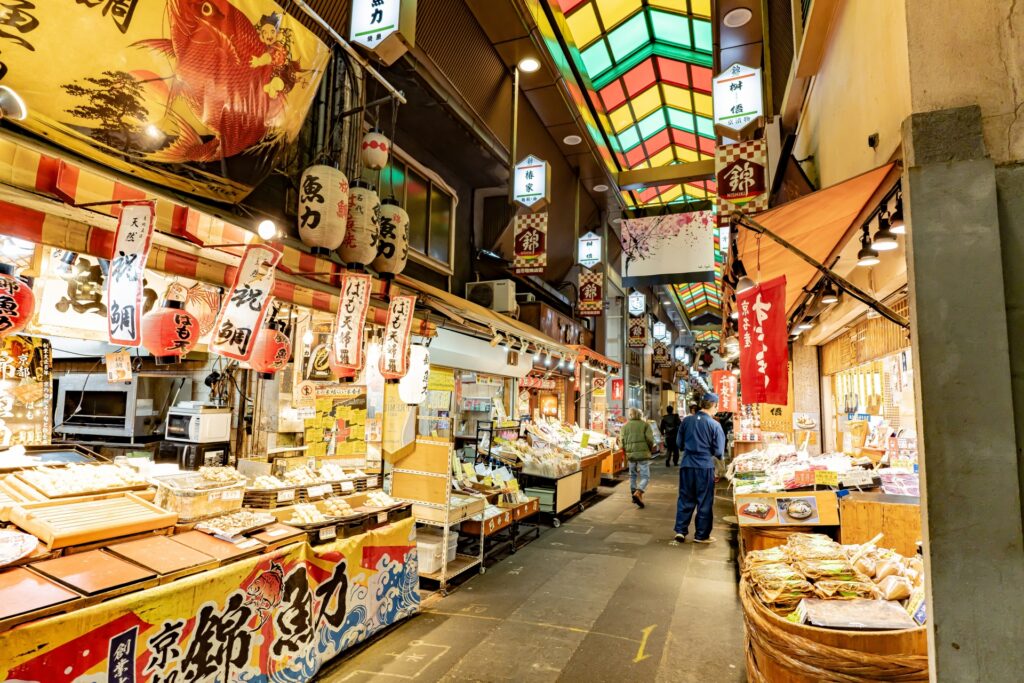

Be sure to find stalls brimming with Kyoto’s culinary treasures—fresh seafood, vibrant pickles, Kyoto’s local flavors, and the elusive matcha-infused sweets.
Savor the city’s rich culinary history with every delightful bite
5. Gion District and Traditional Japanese Entertainment:
Famous for its traditional wooden machiya houses and as the historic geisha district, Gion offers a glimpse into Kyoto’s past.
Gion is renowned as an iconic area where geishas, traditional Japanese female entertainers skilled in various arts, reside and practice their traditional arts. The district is synonymous with the elegance, cultural richness, and mystique associated with geisha culture, making it a focal point for those seeking an authentic glimpse into traditional Japanese entertainment and hospitality.

In this historic district, you’ll find teahouses draped in elegance. Obviously their doors harboring the secrets of traditional Japanese entertainment.
Anticipate the enchanting sight of geishas gracefully gliding in their traditional attire as you stroll through Gion, Kyoto.
Gion transports you to an era where the arts flourished, and every lantern-lit alley conceals tales of grace and elegance.
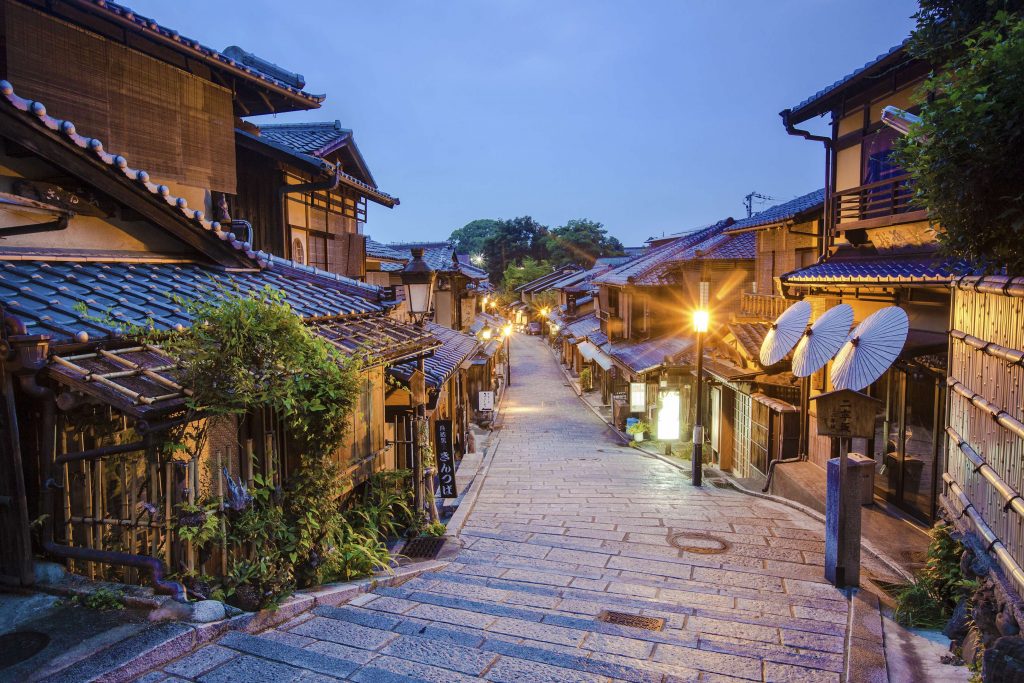

The preservation of machiya, traditional wooden townhouses, adds a touch of nostalgia to the cityscape.
To experience an authentic glimpse into traditional Japanese entertainment and hospitality in Gion Kyoto, consider the following:
Hanami-Koji Street:
Wander along Hanami-Koji Street, the main street in Gion, especially in the early evening. This is when you may encounter geishas and maikos (apprentice geishas) on their way to appointments. Keep in mind that respecting their privacy is crucial, so avoid intrusive photography.
Tea Houses and Ochaya:
Gion is home to numerous tea houses and ochaya (traditional Japanese entertainment establishments). While entry to these places may be exclusive and by invitation, some offer cultural experiences, such as tea ceremonies, where you can appreciate the refinement of traditional hospitality.
Gion Corner:
Visit Gion Corner, a cultural center offering daily performances introducing traditional Japanese arts, including tea ceremonies, ikebana (flower arranging), and geisha dances. It provides a comprehensive overview of various cultural practices. Gion Corner surely offers a concise and well-organized program, allowing visitors to witness multiple aspects of traditional Japanese arts in a relatively short duration.
Attend Special Events:
Check for special events and festivals in Gion, especially during the spring and fall seasons. Particularly, Gion Matsuri, one of Japan’s most famous festivals, is held in July and features parades and traditional performances. The highlight of Gion Matsuri is its vibrant and elaborate parades, featuring massive floats adorned with intricate ancient artifacts, and traditional art. These processions showcase the craftsmanship and artistic heritage of Kyoto.
Stay in a Ryokan:
Consider staying in a ryokan (traditional Japanese inn) in Gion. Ryokans typically feature tatami mat flooring and futon bedding, offering a genuine Japanese sleeping experience. It’s a departure from standard hotels and provides a more immersive connection to traditional Japanese living.
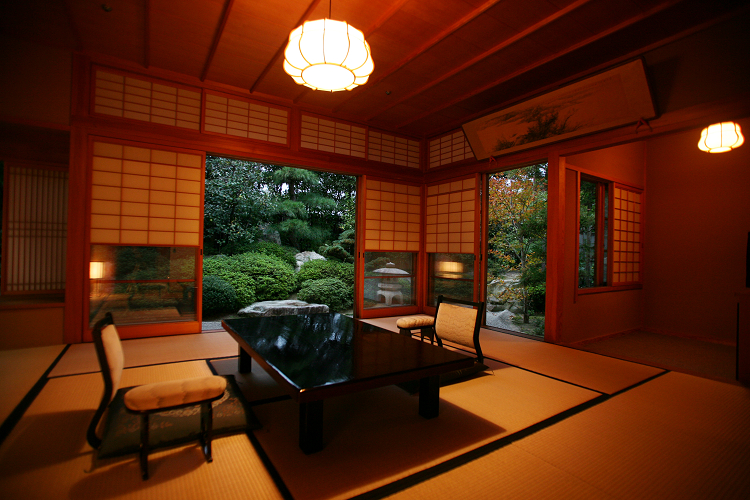
Some ryokans offer a glimpse into traditional hospitality with tatami rooms, kaiseki meals, and the chance to experience the calm and elegant atmosphere.
In addition, some Ryokans have onsen(hot springs) facilities, allowing you to experience the rejuvenating ritual of Japanese hot spring baths. It’s a relaxing and significant way to unwind after a day of exploration.
6. Historical and Cultural sites in Kyoto Japan:
Kyoto is rich in cultural, historical, and natural sites.
Nijo Castle:
Step into the hallowed halls of Nijo Castle in Kyoto Japan, and you’re not just exploring history; you’re unraveling a tale of shogun intrigue. Known for its “nightingale floors” that chirp when walked upon, Nijo Castle was built in the 17th century and served as the residence of the Tokugawa shoguns. The castle complex includes Ninomaru Palace, a lavish palace with multiple chambers and reception halls.


Marvel at the opulent architecture, where sliding doors adorned with vibrant artwork lead you through a maze of chambers. The gardens, a serene escape, offer relief from the political dramas that once echoed within. Nijo Castle is more than a monument; it’s a time capsule, preserving the whispers of Japan’s feudal past in every creak of its floors and beauty of it’s artwork.
Fushimi Inari Taisha:
Hike the torii-lined pathways of Fushimi Inari Taisha, where a thousand iconic torii gates lead the way to sacred Mount Inari


Fushimi Inari Taisha is a mesmerizing journey through a corridor of vivid orange torii gates that dates back to 8th century. As you ascend the sacred Mount Inari, the vibrant gates create an otherworldly tunnel, with moss-covered stone pathways. Each step feels like a passage through time, and the panoramic views of Kyoto from the summit are nothing short of breathtaking. Fushimi Inari Taisha beckons with a serene beauty amidst the whispers of rustling leaves and the soft glow of lanterns.
Kyoto Imperial Palace:
The former ruling palace of the Emperor of Japan, surrounded by beautiful gardens. Step into the realm of emperors. Surrounded by meticulous gardens and ancient walls, the palace unveils a tranquil oasis in the heart of Kyoto Japan. As you wander through the meticulously designed grounds, you’re not just exploring a palace; you’re immersing yourself in the refined traditional Japanese architecture.
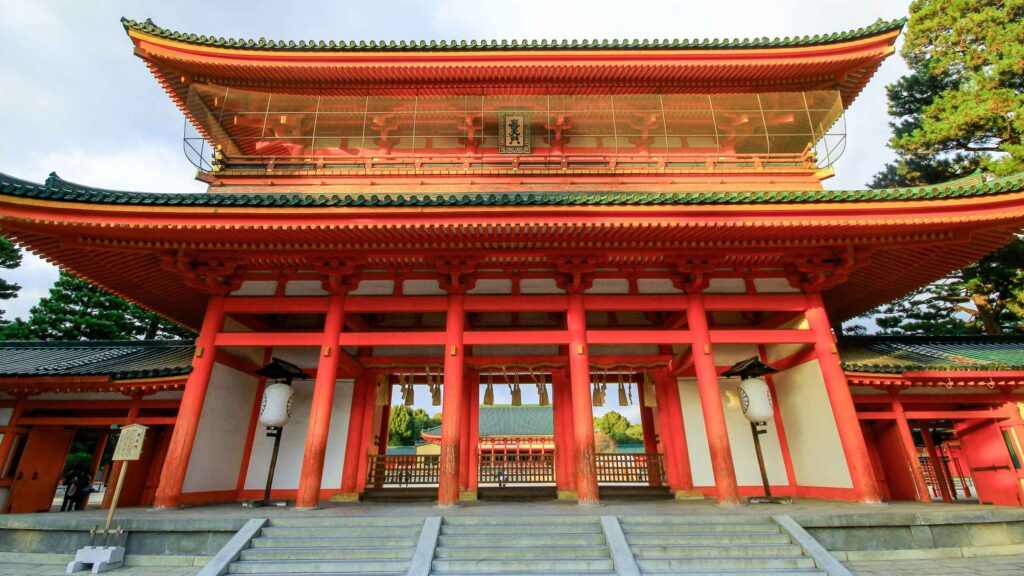

The Shishinden, where imperial ceremonies take place, and the Seiryoden, the emperor’s residence, are architectural marvels that speak volumes about the grandeur of the imperial court. Kyoto Imperial Palace is a captivating journey back in time, where the lives of bygone eras linger in the air, waiting to be discovered by those who tread its sacred grounds.
Kyoto International Manga Museum:
While not a historical site in the traditional sense, this museum is unique in that it houses a vast collection of manga, showcasing Japan’s modern cultural history.


The Kyoto International Manga Museum is a haven for manga enthusiasts and cultural explorers alike. Shelves upon shelves, towering from floor to ceiling, each laden with thousands of manga from every genre imaginable. There is a diverse collection of manga in various languages, including translations. What makes it truly fascinating is that these books aren’t just for display—they’re there for you to read. The museum encourages an interactive experience, allowing visitors to freely browse, borrow, and even contribute to the vast manga collection. It’s a dynamic celebration of Japan’s modern storytelling art, where manga isn’t confined to pages but spills into the vibrant atmosphere, fostering a unique and immersive cultural exchange for all comic lovers. In the heart of Kyoto, this museum is a living, breathing dialogue between creators and readers, making it a must-visit for anyone curious about the ever-evolving world of manga.
Expectations and Surprises in Kyoto Japan
1. Crowded Streets and Hidden Havens: Anticipate the crowds, especially during peak seasons, but embrace the art of discovering hidden havens. Away from the bustling streets, you’ll find secluded temples and charming teahouses that offer a more intimate Kyoto experience.
2. Rituals and Respect: Respect for tradition runs deep in Kyoto. Observe local customs, from removing your shoes before entering a traditional ryokan to maintaining a respectful distance during cultural ceremonies. The city rewards those who immerse themselves in its rich culture with genuine warmth and openness.
The People of Kyoto Japan
Kyoto’s residents, from the graceful geisha to the humble shopkeeper, embody the city’s spirit. Engage in conversations at local markets, where artisans showcase their crafts, and let these exchanges enrich your journey. In Kyoto, authenticity is not a trend—it’s a way of life. It’s the genuine smile of a local shopkeeper as they hand you a freshly crafted wagashi (traditional Japanese desserts).
Navigating Kyoto’s Diverse Treasures: A Tactical Guide for Exploring the City
Kyoto’s enchanting allure sprawls across a landscape rich with cultural gems, each beckoning with its own unique charm. To ensure you make the most of your visit to this historically layered city, consider this strategic guide for navigating its spread-out attractions.
1. Prioritize Attractions:
Identify the key attractions you want to visit and prioritize them based on your interests. Narrow down your must-see list will help you plan your days effectively.
2. Group Attractions by Location:
Kyoto is divided into different districts, each with its own unique charm. Group attractions that are close to each other geographically to maximize your time and minimize travel between sites. For example, explore Higashiyama’s temples and Gion together.
3. Use Public Transportation:
Kyoto has an efficient public transportation system, including buses and trains. Consider purchasing a Kyoto City Bus Pass or a Kyoto Sightseeing Card for unlimited rides on buses and subways within the city. This will make it easier to navigate between attractions.
4. Rent a Bicycle:
Renting a bicycle can be a convenient and enjoyable way to explore certain districts, especially if your chosen attractions are relatively close to each other. This proves effective because Kyoto is a bike-friendly city with many cycling paths.
5. Consider a Guided Tour:
Joining a guided tour, whether walking or by bus, allows you to focus on the experience rather than navigating the city on your own.
6. Early Mornings:
Visit popular attractions early in the morning to avoid crowds. This is especially true for places like Fushimi Inari Shrine and Kinkaku-ji, which can get busy later in the day.
7. Stay in a Central Location:
Consider booking accommodation in a central location, such as the Gion district or near Kyoto Station. This makes it easier to access transportation and minimizes travel time to various attractions.
8. Allow for Spontaneity:
While it’s good to have a plan, allow for some flexibility in your schedule. Serendipitous discoveries and unplanned detours can lead to hidden gems and unexpected delights.
Remember to check the opening hours and any admission fees for each attraction. Additionally consider purchasing a Kyoto City Pass or a Kyoto-Osaka Sightseeing Pass for additional savings on transportation and entry fees.
Kyoto’s Legacy
Overall, Kyoto is more than just a destination. It’s an immersive journey that invites you to dance with time, explore the unexpected, and forge connections that linger long after you’ve bid the city farewell. Undeniably, it’s the reverence felt in the presence of a centuries-old torii gate, standing tall and proud. The quiet contemplation by the Zen rock gardens, where the carefully placed stones echo the tranquility of a meditative mind. It’s the laughter shared over a bowl of ramen in a bustling izakaya, where strangers become friends in the companionship of shared stories.
In Kyoto, the magic is not just in witnessing history; it’s in becoming a part of it. It’s in the authenticity that seeps through every stone, in the rituals that invite you to partake, and in the genuine warmth of the people who call this city home. As you traverse Kyoto’s timeless streets, you’re not merely a traveler; you’re a custodian of the city’s legacy, a seeker of stories waiting to be uncovered.

